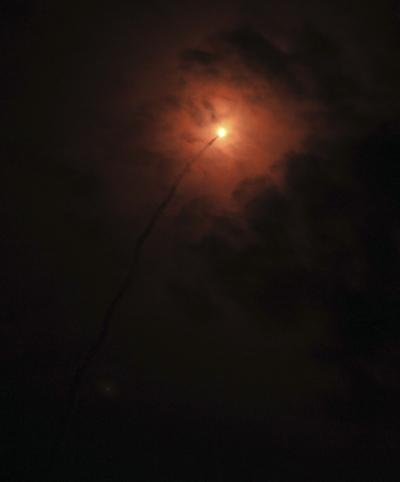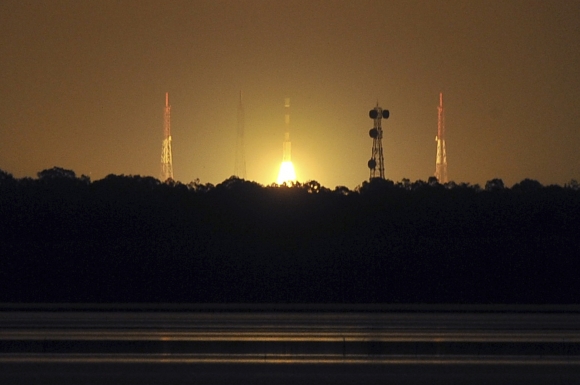Photographs: Babu/Reuters
Joining a select group of nations, India entered a new era in space applications with its first dedicated navigation satellite being successfully put into orbit by its polar rocket PSLV that will give the country an alternative to United States’ global positioning system.
In a midnight launch, India's workhorse 44-metres tall Polar Satellite Launch Vehicle blasted off in a perfect text book launch at 11.41 pm on Monday night carrying the indigenous IRNSS-1A from the Satish Dhawan Space Centre in Sriharikota, Andhra Pradesh, painting a dense golden flame in the dark canvas of the sky.
IRNSS-1A is the first of the seven satellites constituting the independent Indian Regional Navigation Satellite System space segment that is designed to provide accurate position information service to users in the country as well as the region extending up to 1,500 km from its boundary, which is its primary service area.
An elated ISRO chairman K Radhakrishnan said the IRNSS-1A satellite, with a lift-off mass of 1,425 kg, was precisely injected into its intended orbit, 20 minutes after the launch, in the first step for an exclusive navigation system. IRNSS-1A was launched at a cost of approximately Rs 125 crore, he said.
"This only proves that PSLV is an extremely reliable vehicle and with this flight, we are also entering into a new era of space application in the country that is the beginning of satellite navigation programme," he said after the launch.
...
India's first dedicated navigation satellite launched
Image: India's Polar Satellite Launch Vehicle PSLV-C22, carrying India's first navigation satellite system IRNSS-1A, lifts off from the Satish Dhawan Space Centre in SriharikotaPhotographs: Babu/Reuters
With ISRO scientists breaking into celebrations, Radhakrishnan said, "I am extremely happy to announce that we had another excellent flight of our PSLV vehicle. This is the 23rd successive successful flight of PSLV and the fourth successful flight of extended version of PSLV."
IRNSS will be on the lines of United States' GPS, Russia's global orbiting navigation satellite system, European Union's Galileo, China's BeiDou satellite navigation system and Japan's Quasi-Zenith Satellite System.
IRNSS applications include mapping and geodetic data capture, precise timing, visual and voice navigation for drivers, integration with mobile phones and terrestrial, aerial and marine navigation, terrestrial navigation aid for hikers and travellers. It is the first of the seven satellites constituting the IRNSS space segment with three of them in geostationary orbit and four in inclined geosynchronous orbit. IRNSS, which has a mission life of 10 years, has a space and ground segment.
The next satellite of the series IRNSS-1B is due for launch early 2014. The full constallation of seven satellites is supposed to be in orbit by 2015 and only then will the service of the IRNSS system take off.
Earlier, a glitch in one of the electro-hydraulic control actuators in the second stage of PSLV-C22 had forced ISRO to postpone the launch of IRNSS-1A on June 12 by a fortnight. It was rescheduled for July 1 after the anomaly was rectified.
...
India's first dedicated navigation satellite launched
Image: India's Polar Satellite Launch Vehicle PSLV-C22, carrying India's first navigation satellite system IRNSS-1A, lifts off from the Satish Dhawan Space Centre in SriharikotaPhotographs: Babu/Reuters
Having a lift-off mass of 1,425 kg, the satellite was launched into a sub Geosynchronous Transfer Orbit with a 284 km perigee (nearest point to Earth) and 20,650 km apogee (farthest point from the Earth) with an inclination of 17.86 degree with respect to the equatorial plane It is the first of the seven satellites, constituting the Indian Regional Navigation Satellite System space segment with three satellites in geostationary orbit and four satellites in inclined geosynchronous orbit.
IRNSS applications include mapping and geodetic data capture, precise timing, visual and voice navigation for drivers, integration with mobile phones and terrestrial, aerial and marine navigation, terrestrial navigation aid for hikers and travellers.
On the late night launch operation by ISRO for the first time, and ISRO official had said, "The timing of the launch is determined by the orbital parameter and the inclination. The requirements for IRNSS-1A needed a mid-night launch."
Hailing the successful launch of IRNSS-1A satellite, Prime Minister Manmohan Singh described it as an "important milestone in the development of India's space programme". He congratulated the scientists responsible for the successful launch of the satellite. "India's space programme is playing an increasingly important role in socio-economic development of the country," the PM said in a statement.




article